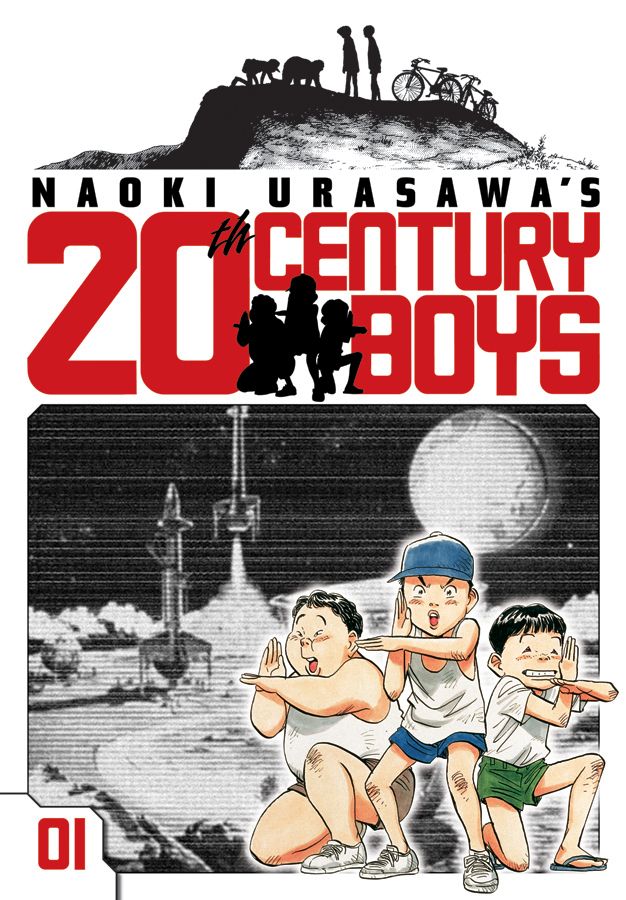20th Century Boys by Naoki Urasawa
In 1969 Kenji and his friends spent their summer in their secret fort, dreaming up stories of how bad guys would take over the world and how they would be thwarted by heros in the end (since after all, that's how stories always go). Decades pass and life is better for some of them than others, Kenji is back working at his parent's convenience store and looking after his sister's daughter when weird things start happening. A new cult is on the rise, the Friends, and aside from being generally rather creepy they seem to also know what happened that summer and someone is determined to make that Book of Prophecy Kenji and his friend's wrote a reality.
In some ways it's rather appropriate that I ended up waiting until 2014 to review this series (just had a hard time getting a hold of some of the volumes) since part of this story is set in 2014 and while I wouldn't say one section of the story is my favorite the 2014 part does feature my favorite characters, Kanna and Kyozumi. However it's a bit hard to talk about them without giving away too much of the story considering just how many years the story spans. So far the story is set in more or less three distinct periods, the late 1960s/early 1970s, where Kenji and his friends are middle schoolers and everything starts, in the late 1990s leading up to the year 2000 when their childhood stories are set, and then 2014 where, well, you can guess what's happened if the story is still continuing. In the earlier volumes the 1990s were the "main" setting, jumping back to the 60s/70s to explain certain things, and around volume six it starts changing to where 2014 is the main setting and then jumps back to both the 90s and the earlier period to explain what's going on. If that sounds confusing then yes and no, I found that keeping a grasp on the various plot-threads and how they influenced each time frame was doable, however they do start piling up rather quickly as do the number of characters.
Speaking of the characters, this series has an enormous number of them especially since many of them are involved in at least two, if not all three, time frames and even though I only had a small gap between reading various chunks of the series I was starting to have a hard time keeping everyone straight. Urasawa thankfully is a master of drawing faces, he can draw dozens of different characters and have them all look distinct yet clearly like they come from the same story, he even manages to make the characters who appear both as children and middle aged adults resemble each other in a very natural way. I still maintain however that each volume needs a much bigger character chart than it actually has, especially since I was worried that if I googled any of the characters that I would be horrendously spoiled. I am however a bit grumpy at just how few female characters there are, by my count we have five, maybe six important female characters by the 14th volume and over 20 main male characters and while I can see why it was written that way (considering that the cast spread out from a group of boys in the middle of their "ew girls have cooties phase") it still bothers me.
So, what about the story? Well, as with his drawings I am impressed at how long and complicated Urasawa has made this plot. Early on I found myself going "is this all? We seem to be gearing up for the endgame but there are so many volumes left," and of course that wasn't it, the conspiracy of the Friends just got deeper and deeper yet always remained within my suspension of disbelief. Perhaps it's the absurdity that makes it work, that someone is seriously taking the story a bunch of kids made and making it real, but of course that's why it does work, who would believe that except a bunch of manga readers (which the series itself even sneakily acknowledges with some of it's side cast). To say the story is absurd doesn't quite work, its setting and cast are much too grounded in reality, but it is crazy to watch the plans unfold and see just how far the conspiracy goes, although I think by the end of the 14th volume it does feel like we're starting to leave that realistic setting behind and enter the world of science fiction more and more. I am a bit sad, yet unsurprised, by that and just hope that no matter how crazy the story continues to get that it stays true to the characters and keeps having all of them, from the teens and young adults to the middle aged characters, grow and develop in interesting ways. I will certainly be seeing if there's a way to read the rest of the series, I haven't looked into what the interlibrary loan system is like out here, and I do recommend the series to anyone who likes long, involved plots that throws it's characters into a strange mix of science fiction and modern day reality.

